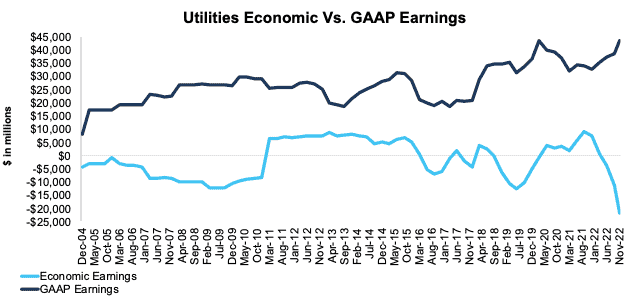Economic earnings for the S&P 500 dropped quarter-over-quarter (QoQ) in 3Q22, a trend that began in 1Q22. Economic earnings decreased QoQ for every sector except Energy through the trailing-twelve-months (TTM) ended 3Q22.
This report is an abridged and free version of S&P 500 Economic Earnings: Downward Trend Continues In 3Q22, one of our quarterly series on fundamental market and sector trends. The full reports are available to those with our new Professional (previously known as Unlimited) and Institutional membership or can be purchased below.
The full version of this report analyzes the economic earnings[1] (which adjust for unusual items on both the income statements and balance sheets) and GAAP earnings for the S&P 500 and its sectors (last quarter’s analysis is here).
Economic earnings provide a more accurate measure of the true underlying cash flows of businesses than GAAP earnings. Reports on the drivers of economic earnings are here.
This report leverages our cutting-edge Robo-Analyst technology to deliver proven-superior[2] fundamental research and support more cost-effective fulfillment of the fiduciary duty of care.
Economic Earnings Fall in 3Q22
Economic earnings for the S&P 500 fell from $858.5 billion in 2Q22 to $785.9 billion in 3Q22, while GAAP Earnings fell from $1.74 trillion to $1.69 trillion over the same time. Despite falling in the quarter, economic and GAAP earnings remain near record highs and have not fallen to anywhere near pre-pandemic levels.
The S&P 500’s soaring economic earnings have fallen quarter-over-quarter in each of the past three quarters, a trend we noted was likely in our 1Q22 report S&P 500 Economic Earnings Set Records, but WACC Is a Drag. Indeed, a major headwind facing economic earnings is a rising WACC. Inflation boosts GAAP earnings, but these gains are erased in economic terms by a higher cost of capital. Investors can protect themselves from such false signals by paying closer attention to economic earnings, which accounts for the effects of expected inflation on a firm’s WACC.
See Figure 1 in the full version of our report for the chart of Economic Earnings vs. GAAP earnings for the S&P 500 from December 2004 through 3Q22.
Key Details on Select S&P 500 Sectors
GAAP Earnings overstate the decline in profits, relative to Economic Earnings, for the Financials, Healthcare, and Consumer Non-cyclicals sectors. On the flip side, GAAP Earnings overstate the increase in profits, relative to Economic Earnings, for the other eight sectors.
Only the Energy sector saw QoQ improvement, $30.5 billion, in economic earnings, which rose from $76.3 billion in 2Q22 to $106.8 billion in 3Q22.
The Technology sector generates the most economic earnings of any sector, but its economic earnings fell by 7% QoQ in 3Q22. On the flip side, the Utilities sector has the lowest economic earnings and was one of ten sectors that destroyed shareholder value in 3Q22.
Below, we highlight the Utilities sector, one of the sector’s which saw the largest difference between the QoQ change in economic earnings and GAAP earnings in 3Q22.
Sample Sector Analysis[3]: Utilities
Figure 1 shows economic earnings for the Utilities sector fell from -$11.3 billion in 2Q22 to -$21.8 billion in 3Q22, while GAAP earnings rose from $38.5 billion to $43.4 billion over the same time.
Figure 1: Utilities Economic Earnings Vs. GAAP: 2004 – 3Q22
Sources: New Constructs, LLC and company filings.
Our economic earnings analysis is based on aggregated TTM data for the sector constituents in each measurement period.
The November 25, 2022 measurement period incorporates the financial data from calendar 3Q22 10-Q, as this is the earliest date for which all the calendar 3Q22 10-Qs for the S&P 500 constituents were available.
This article originally published on December 8, 2022.
Disclosure: David Trainer, Kyle Guske II, Matt Shuler, and Italo Mendonça receive no compensation to write about any specific stock, style, or theme.
Follow us on Twitter, Facebook, LinkedIn, and StockTwits for real-time alerts on all our research.
Appendix: Calculation Methodology
We derive the economic earnings and GAAP Earnings metrics above by summing the Trailing Twelve Month individual S&P 500 constituent values for economic earnings and GAAP Earnings in each sector for each measurement period. We call this approach the “Aggregate” methodology.
The Aggregate methodology provides a straightforward look at the entire sector, regardless of market cap or index weighting and matches how S&P Global (SPGI) calculates metrics for the S&P 500.
[1] This report is based on the latest audited financial data available, which is the 3Q22 10-Q in most cases. Price data as of 11/25/22.
[2] Our research utilizes our more of reliable fundamental data, as proven in Core Earnings: New Data & Evidence, written by professors at Harvard Business School (HBS) & MIT Sloan and published in The Journal of Financial Economics.
[3] The full version of this report provides analysis for every sector like what we show for this sector.

